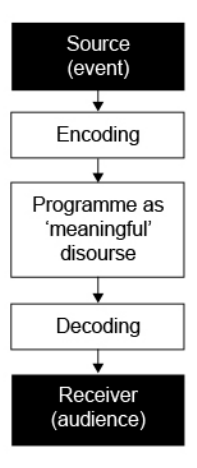What is Encoding and Decoding?
The encoding and decoding theory, theorised by Stuart Hall, describes how producers use various signs to encode a media text or programmeвАЩs meaning according to their ideologies and resources. It is then transmitted through various channels and the audience then decodes the hidden meanings by applying their own cultural and personal perspectives to the media product.

Within the decoding process, there are three different positions. This is also commonly referred to as Stuart Hall’s Reception theory, which briefly states that there are three different ways in which audience members can interpret a media product. These are:
- Dominant/hegemonic reading: audiences completely adopt and concur with the encoder’s intended message. They interpret the message in a way that is aligned with the producer’s original intent. For example, the audience interprets a commercial for a product as intended, meaning they should purchase it.
- Oppositional reading: the intended meaning of the encoded message is directly contradicted when audiences reject or oppose it. They pose a serious challenge to the established ideas. For example, some people may interpret a political advertisement endorsing a particular candidate as deceptive or manipulative.
- Negotiated reading: the intended message is partially accepted and partially rejected by the audience. They interpret the message while adding their own interpretations, changing its meaning to suit their own ideas. One instance is when people like a TV show but have issues with some of the themes or ideas it presents.
The process of encoding and decoding can be observed in many different aspects in society and the media – after all, it is simplified down to how consumers perceive a text. For example, we can apply this to social media activism. Users on social media platforms interpret content from different sources. Some people will completely agree with a post that promotes a cause (dominant), while others will participate critically and support certain points while challenging others (negotiated), and others will reject the message in its entirety because they hold opposing views (oppositional). A contemporary example of this is Rishi Sunak’s family celebrating Diwali this year, right after aiding and supporting Israel on the recent attacks regarding the Palestinian genocide.
- Hegemonic reading: There was no opposition to Sunak’s joyous celebration of Diwali with his family, especially among those who support the Conservative Party and are pro-Israel.
- Oppositional reading: On the other hand, a significant number of individuals (presumably pro-Palestine) expressed no gratitude at all for this. They said that Sunak should not be honouring the festival of light since he has contributed to Israel’s success and is therefore responsible for the deaths of Palestinians. Numerous others have also expressed their disapproval of Diwali being celebrated on the same weekend as Armistice Day, which honours those who lost their lives in World War I. This has led to many people developing overt racism and hinduphobia towards Sunak.
- Negotiated reading: A lot of people were offended by these remarks as well. They held that it was acceptable to criticise Sunak for political choices that you disagreed with without also insulting his race or religion.
Reference list:
Stuart Hall (cultural theorist) (2023) Wikipedia. Available at: https://en.wikipedia.org/wiki/Stuart_Hall_(cultural_theorist) (Accessed: 18 November 2023).












This is really a wonderful blog! The article clearly and concisely explains what is encoding and decoding, and leads to three ways of interpreting decoding. For the examples given in the paper, it is very attractive to closely follow the theory given. If you can describe some of your own opinions in the article, it will be better. For example, since the process of encoding to decoding may be propagated through a constant loop, is the information received by the recipient true and reliable? Does the recipient need to self-identify before publishing their own decoding on the Internet? The impact of such a mode of communication……
Thank you for the feedback!! This is a really good point – I do think that a consumer’s formation of identity (things like their religious beliefs, interests and political stance) does play a big role in the way that they decode materials around them. In terms of the truthness and reliability of the information they receive, I will agree that fake news is very real and is constantly spreading and circulating around the internet, so the way that a consumer decodes a text will change depending on how ‘real’ the information is.
Hey! I think this post is great. I love the way you’ve included a modern day hot topic as an example. It’s extremely current and relevant to the topic and reinforces your points as well as the theory brilliantly. You’ve done a good job!
Thank you, Jay! I think it is important to show current topics when having discussions about topics like these to prove that these concepts and theories are still relevant to this day.